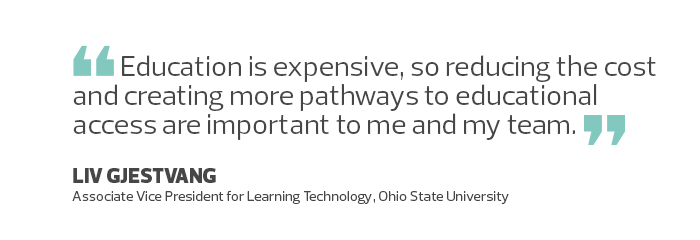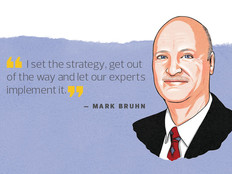Leading Edge: Ohio State's Liv Gjestvang on Creating a Healthy Workplace Culture
The opportunities and the growth I’ve had at Ohio State are closely connected to the leaders I’ve worked with. They’ve mentored and supported me, giving me the space to do work that matters to me.
I have a strong commitment to social justice. Our team is doing a lot of work with open content and affordability for students. Education is expensive, so reducing the cost and creating more pathways to educational access are important to me and my team. We talk to students who struggle with whether to pay for food or buy a $240 textbook. We want to reduce the cost of course content to zero where we can, but are also looking at ways our team can support faculty in course redesign to transform teaching and learning.
With Ohio State’s Affordable Learning Exchange, our team works to provide grants and instructional support for faculty. We don’t have a single pathway faculty have to go down, but we customize for them. We want to shift the pedagogy toward more engaging strategies. Some faculty use our learning management system and identify articles in the library that students can access. Some use the Pressbooks authoring tool where they can create their own interactive, browser-based content. They can also assign students to do their own research and produce their own content.
What we are finding is that if we are moving to digital content, it actually doesn’t work well to take a traditional paper-based book and turn it into a flat PDF. That’s not using the technology well, and students like that less. But when you use digital for what it’s designed for, which is interactive and allows you to engage with it, such as taking notes or posing a question faculty or peers can respond to, the students enjoy that.
Good Leaders Create Opportunities, Set Limits
As for my leadership style, I enjoy connecting with people. Relationships are important to me and I want our employees to have opportunities to grow and succeed.
One thing that has shifted for me is recognizing that having people who are committed to the team and are really hard workers is wonderful — but people who are so committed sometimes work in ways that are not good for them. I’ve seen people who have pushed themselves past what was physically healthy and people who, at times, put work ahead of their family in ways I don’t think is good. It’s not the culture I want to build.

This is demanding work. We have teams that run the learning management system and a whole range of educational tools. Students have to take final exams and faculty have to submit grades, so these tools have to be up and running all the time. That’s a lot of pressure. People sometimes work late or through the weekend. To me, we need to say, “When you give to us like this, we expect you to take some time and get back to a place where you are healthy, balanced and ready to bring your full game back to work.”
I realized it’s important to place limits. For me, it was figuring out how to help people turn away from the work and not just turn toward it. We have a range of strategies, including wellness programs, social events, a mentoring initiative and flex work programs so people can leave work early a couple of days to spend time with their family, then finish their work in the evenings.
University Leaders Should Support Visionary Tech Use
I love the vision and strategy part of the work I do. Being able to imagine new possibilities and see challenges that we can address is important. Something I’ve had to grow into as a leader is being able to step away from doing the day-to-day projects and figuring out how to support other people leading these initiatives. My team and I meet yearly to discuss, what is the work we are doing that we want to continue? What are the new opportunities we want to pursue? It’s a constant challenge because it’s so tempting to keep looking at what we want to add. At some point, if we continue to expand in new directions, there have to be things we step away from.
I am lucky to have a team of colleagues who are experts in the work they do. They lead our Affordable Learning Exchange and College Ready Ohio programs and are connected to colleagues doing similar work around the country. They strategize around how we move ideas forward. I think about and connect with them about what the big opportunities are, and try to clear the way for them to blaze forward in that work.
Leadership, technology and the mission of higher education are closely connected. We live in a world that’s supported in so many ways by technology. I think a lot about how we support student success with technology. It’s not just using technology for technology’s sake, but having conversations around what students actually need.
What Comes Next for Gjestvang
Over the next several years, we are focusing heavily on our new Digital Flagship Initiative. It’s a collaboration with Apple where we will develop a curriculum for students to learn basic coding skills and create an iOS design lab for Ohio State and the central Ohio community, where people can work with professionals to develop apps. There is also a technology piece in which incoming first-year students will get an Apple iPad, keyboard and other tools, so students who want to access educational content on a mobile device will have an easier way to do that.







